Talking about healthcare emergencies requiring long distance immediate transfer, there can be a handful of services that are both critical and complicated as an air ambulance. The price of every high-speed rescue is defined as a discreet yet volatile blend of aviation logistics, clinical expertise and financial nagging.
Understanding the real cost for air ambulance
The real cost for air ambulance is another thing to quite understand. Despite the fact that averages of $12,000–$25,000 for some short flights or up to and above $80,000 for cross-continental evacuations without insurance, these are numbers that, unfortunately, skyrocket once one adds international protocol, landing permits and, probably, more crew-hours than might seem rational. Essentially, distance still remains the primary distributor of the flights’ costs, but not the only one. The medical team’s specifics, the craft’s type and the equipment required to start the sum. Not similar to any usual aviation billing, such transfers are not paid exclusively per flying time. It also includes ground-handling, patient stabilization or post-flight reports that are not assumed by any cost into regular accounts.
Breaking down air ambulance charges
Behind the official air ambulance charges stands a system combining a base-rate with per-mile increments and numerous service add-ons. If average mile-pricing is $50–350, it varies slightly if the operation is conducted domestically or internationally, generally staying within the aforementioned range.
But typical averages show how steep these digits are:
- If the distance is under 100 miles, such an operation costs approximately $19,000 for the aviation within the same country but already $34,000 if its abroad;
- 100–500 miles usually cost $60,000 for aviation domestically and $105,000 on the international playfield;
- 500+ miles is already in the $100,000 zone for national routes, and here it gets as high as $175,000 for overseas flights.
This data also explains why having travel or medical coverage is a dire necessity. Without one, every hour in the air and every mile of distance will add to the final invoice.
Variables shaping overall air ambulance pricing
The mosaic of air ambulance pricing never results from a single calculator. Each mission receives a custom estimation built around multiple tangible and situational factors:
- First, it is a type of flying-machine. Rotor-wing helicopters dominate short-haul emergency rescues due to fast-takeoff and versatile landing, while fixed-wing planes transfer longer-range movements due to bigger fuel-capacity and more onboard equipment. Helicopters burn more fuel per hour, but planes involve a higher route-planning process and international-permit costs.
- Second, it is distance and duration. Each additional mile adds both flight-crew hours and maintenance wear. Long-distance or cross-border flights demand refuel stops, weather-window coordination, and often international medical-clearance documentation.
- Third, it is healthcare insurance. The presence — or absence — of travel-assistance membership or dedicated air-transport insurance dramatically shifts totals. Without coverage, payments fall entirely on the patient or family. With it, costs may either be pre-paid or reimbursed, depending on the plan structure.
- Fourth, it is provider structure. Private operators tend to bill higher than hospital-owned or government-subsidized fleets, but competition in a region can moderate pricing swings.
Reviewing all these before traveling — especially abroad — often means saving both money and peace-of-mind later.
Understanding air ambulance fees and what they include
The detailed calculation helps to know what an air ambulance fees are for. Typically, it will reflect:
- Ground-transfer to the transport-plane and back to the original hospital;
- On-board medical crew members – pilots, doctors, nurses, paramedics, and physicians;
- Specialized life-support equipment and medication, including but not limited to ventilators, cardiac monitors, and infusion pumps;
- Fuel, navigation, and airport-service fees;
- Insurance, flight-planning, and standby-readiness charges.
International flights bring more items to the list: landing-taxes, overflight-permits, emergency-visas, and final-destination-airport surcharges. There is a price tag on each step. Invoices sometimes reach five digits before the aircraft even leaves the runway. The better regulated the provider is, the more transparently and separately such fees are charged. Less-than-ideal operators sometimes group them all in a single line, making patients feel bad before the real fly. Reviewing the invoice details and legal advice always stands as a good idea.
Covering the bill — insurance and funding alternatives
Covering such a bill for emergency transport generally does not occur in such situations in a controlled manner. Nonetheless, adequate pre-planning may significantly minimize the cost of sudden anxiety when real emergencies arise in the future.
Paying out-of-pocket —many evacuations cost hundreds of thousands of dollars, and in such situation out-of-pocket pays for everything.
If the transport is deemed essential within the protected territory, medical-insurance plans may pay back a portion of the prices. However, as would be the case, deductibles and co-pays are guaranteed, and becoming acquainted with the limitations ahead of time will remove all excess stress.
Real-time coordination, financing, and organization of transportation for one-time fees are all part of travel-assistance memberships. Frequent membership nullified unpredictable one-time invoices.
Travel-insurance programs understand that evacuations are expensive. They frequently provide greater coverage for compensation and maybe prepared to pay in advance.
When comparing these options, it is essential to consider a delicate balance between expenses. Travelers to isolated and politically unstable places should peruse medical-transport clauses carefully before their trip.
Membership vs. insurance — which safeguards better
For those who travel frequently, comparing an every-year agreement and a conventional travel-insurance becomes a matter of choice. While the membership programs deal with logistics themselves, from one call to the direct dispatch of the needed medical-team, flight-coordination, and ground-transport — travel-insurance plans are based on reimbursement. Both models aim to mitigate catastrophic expenses; their difference lies in immediacy and administrative burden. Evaluating which model suits personal circumstances may save lives and capital alike.
From a legal-financial standpoint, membership resembles a pre-paid service agreement, while insurance remains a risk-transfer instrument governed by state regulations.
International nuances in air ambulance pricing
Global air ambulance aircraft have their very own maze of protocol and modifying air ambulance pricing. Beyond sheer distance, these flights are subject to fuel-surcharges, excise-polices, landing-rights foray, and medical-visa requirements for the whole crew. Even weather-structure can hurl a wrench into the cost-pile – diversions and delays extend crew-hours and ground-handling bills.Companies need to attend to fly-over endorsements with each bridge nation and can be forced to resolve the matter quickly and at a premium. Consequently, international rescues nearly always exceed domestic totals, both in hours-flown and in paperwork handled.
Preparing financially and legally for emergencies
Although no traveler anticipates being plucked from a faraway hillside or foreign beach using a medical-equipped aircraft, thousands of them encounter the situation each year. Establishing financial readiness is about checking the policy clauses, knowing emergency hotlines, and confirming that family members or travel-companions are aware of the processes.
What helps more is checking on credible resources such as air ambulance service information from ElClinics to build situational awareness. Moreover, being proactive, as opposed to reactive, transforms chaos into coordinated action, every minute, and every dollar counts.
Practical steps in minimizing exposure
- Verify your personal or corporate policies for its healthcare evacuation benefits.
- Join a global assistance program in case of the need for regular travel, especially to distant places.
- Maintain emergency contacts at hand and the policy-proof available to your attendants at all times.
- Ask for a breakdown of expenses in writing before a non-urgent transfer is agreed upon whenever possible.
FAQ
How much does it cost to use an air ambulance?
Depending on distance and complexity, of total cost range between about $12,000 for a short domestic flight and $80,000 internationally. Costs skyrocket to nearly $200,000 without insurance after the addition of landing fees, medical-crew costs, and equipment-use. Pricing involves a base-charge combined with per-mile fees, which average between $50–$350 per mile, depending on route and conditions.
Who pays for the air ambulance?
Payment varies with coverage. Those with medical-insurance or travel-assistance memberships may have part or all costs pre-covered. Otherwise, payments are made upfront by the client, frequently before flight dispatch. Even with insurance, deductibles and co-pays are done by the client upon arrival. Membership programs pay for and arrange services in advance to avoid typical reimbursement delays in the insurance industry.
Is the air ambulance free will service?
No. Air ambulances are specialized medical-aviation enterprises, not public-service charities. Only limited government-subsidized operations exist, usually for domestic emergencies. There are no free international evacuations. While non-profit entities help in specific cases, the general procedure involves billing based on transparent but substantial commercial terms.











